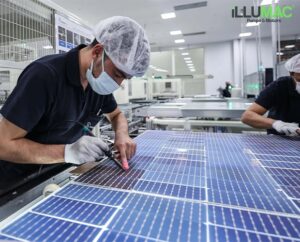In Indian societies, mythology is widely practiced. As a result, various stories and belief systems have found their way into our lives over time. These serve as the skeletons of entire nations, particularly India. However, some myths about solar energy have been passed down alongside these great mythologies. It’s past time to address them.
Myth #1: All solar systems continue to function even when the power goes out.
In the event of a power outage, a building powered by a grid-connected solar power system will lose power. Buildings that are completely off-grid and/or run on a hybrid system will continue to use solar power during daytime power outages.
Backup batteries can be combined with a grid-connected system to provide 100% uptime. Installing backup batteries ensures that you have power even during a power outage. Batteries are used to store solar power generated by solar panels in off-grid, off-the-grid, and hybrid systems.https://illumac.in/what-materials-are-used-to-make-solar-panels-solar-panel-cell-types-and-components-are-described/
Myth #2: Warmer climates are better for solar energy generation
Solar panels use the sun’s light rather than its heat. Solar panels lose efficiency when exposed to high temperatures. Furthermore, during the cloudy or rainy season, solar panels do not completely shut down. They are still operating at 50% efficiency. Furthermore, excess energy produced during the summer months is available in the form of energy credits/money to be used during times when there is little solar energy production.
As a result, cities with moderate annual temperatures, such as Bangalore, are better suited for solar than cities with higher annual temperatures, such as Chennai.
Myth #3: Wind, birds, and other animals can cause damage to solar panels.
To get the most out of your investment, clean your panels once every 15 to 30 days.
Myth #4: The majority of Indians cannot afford to own a solar power system
Many of us believe that switching to solar is a luxury option available only to the wealthy. This is not correct. Solar’s falling costs and the availability of financing options such as loans and government subsidies have made solar a viable option for all property owners. Solar energy generation incentives are available to property owners.
You’ll see savings right away if your solar installation meets 100 percent of your electricity needs and your monthly solar lease fee/loan installment is less than your typical electricity bill.
You may be wondering what the ROI (return on investment) and payback period are. Most customers see a return on their solar investment within 5 to 7 years. Once your investment is repaid, the power generated by your system is free for the next 18 to 20 years.
Myth #5: Manufacturing solar panels is bad for the environment because they use more energy than they produce.
The embodied energy is the energy used to extract, refine, transport, and manufacture a product. Many older studies have discovered that solar panels typically generate enough energy to pay back the embodied energy within 3-4 years. However, panel efficiency and manufacturing processes have advanced significantly in recent years, reducing the amount of time required to compensate for embodied energy.
As a result, if a panel produces energy efficiently for 20-25 years, it will easily repay the embodied energy and offset thousands of tonnes of emissions over its lifetime.
Myth #6: Solar panels cause roof damage.
Myth #7: To go solar, you must own a building.
Myth #8: You can't run heavy loads like air conditioners or heaters on solar power.
You most certainly can. Companies such as Illumac can assist you in calculating your daily energy requirements and determining how many solar panels you will require to meet those requirements. 1 kW (3 solar panels) generates about 4 units of energy per day. As a result, a typical 3-4 BHK house in Bangalore would require 12-15 solar panels to meet their daily energy needs.https://en.wikipedia.org/wiki/Renewable_resource
Myth #9: All solar panels are made in China.
In India, there are numerous well-known solar manufacturers. As in Illumac.
Indian mythology serves as a vehicle for people to share their stories and a sense of belonging. However, spreading false information about climate change, renewable energy, and clean technology can prevent us from becoming more sustainable.https://illumac.in/about-us/






